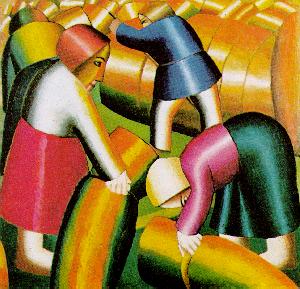Oil on canvas, 72 x 74.5 cm. Stedelijk Museum, Amsterdam.

Oil on canvas, 72 x 74.5 cm. Stedelijk Museum, Amsterdam.

 Taking in the Harvest, also known as Taking in the Rye, is one of the most "radical" expressions of the Cubo-Futurist movement (Gray 150). Though short-lived (lasting perhaps for a year or two), this movement is noteworthy for two main reasons:
Taking in the Harvest, also known as Taking in the Rye, is one of the most "radical" expressions of the Cubo-Futurist movement (Gray 150). Though short-lived (lasting perhaps for a year or two), this movement is noteworthy for two main reasons:
Cubo-Futurism was a movement unique to Russia
most of the Russian artists of the period passed through the Cubo-Futurist phase before moving on to completely non-objective art.
Combining elements of French Cubism, Italian Futurism, and Neo-primitivism, Cubo-Futurism was more or less a natural stepping stone for Russian art as it began to free itself of European influences and once again established itself as a leading force in the development of the world art.
As one of the most creative and inspired artists of the Russian avant-garde, Malevich was well qualified to become one of the leaders of the Cubo-Futurist movement. Taking in the Harvest expresses particularly well both Malevich's artistic temperament and the essence of the Cubo-Futurism. The color of the painting may be what strikes viewers most forcibly. The unnatural, bright metallic coloring is unexpected and, compared to other works of the time, perhaps a little shocking. If the color isn't surprising enough, however, the geometric quality of the figures certainly is -- at least from a "realistic" point of view.
Though the painting is unusual, there is nothing incongruous or inharmonious about its form and composition. In fact, a kind of "cubo-dynamic rhythm" reigns here; one senses that the figures and the bales of rye depicted on the canvas really belong there. Every movement, every bend of a body, every curve fits -- aesthetically as well as metaphorically. The simplicity of the work is also remarkable and, together with other Russian neo-primitivist paintings, harkens back to folk art and the icon painting tradition. Even the absence of perspective (except as indicated by the scale of figures) is reminiscent of icons. The impetuosity and the energy of Taking in the Harvest promises to propel the Russian avant-garde art in general, and Malevich's work in particular, into the unexplored dimension of abstract or non-representational art. [C.B.]
